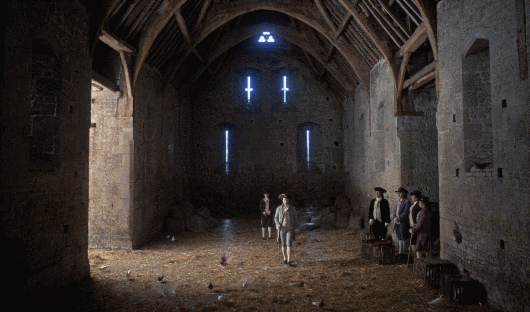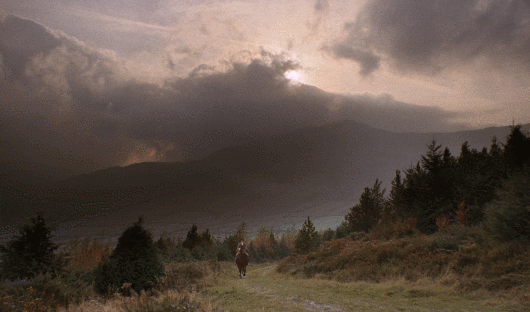Napoleon is one of Stanley Kubrick’s most famous unfinished projects. It was to be his next film after 2001: A Space Odyssey, and for two years he fastidiously conducted research of the era, which was to be set between the late 18th and early 19th century. He went even as far as scouting locations and enlisting the help of the Romanian army for the large-scale battle sequences. However, a potentially prohibitive budget (and cost overrun concerns that would come with it) plus the box office failure of the similar Waterloo doomed the project, and he moved on to A Clockwork Orange. A few years later, deciding that all the copious research he and his assistants did for Napoleon would not go to waste, Kubrick unearthed it all for an adaptation of Thackeray’s The Luck of Barry Lyndon, about the life of Redmond Barry, an Irishman who swindled his way into aristocracy, set during a similar time frame as Napoleon.
Barry Lyndon celebrates its 43rd anniversary this coming Tuesday, and for this week’s Film Frame Friday we want to shine a light on its most remarkable, striking and enduring aspect: its gorgeous cinematography, specifically the use of lighting and the influence of 18th century painters in its composition and overall look.
The Illusion of Natural Light

In order to capture the look of 18th century life, Barry Lyndon strives above all to provide a very naturalistic look to the picture, as if natural light was the only light source in the film. This is however merely an illusion. Artificial lights called “mini-brutes” were used in scenes where light seeped in through windows in the many stately homes that are used as locations in the film.

Shooting with only natural light proved impractical, as the shoot required to go from eight o’clock in the morning until late at night, and the quality and effect of the lighting needed to remain consistent throughout. In addition to that, during wintertime on location in Ireland and England natural light was only available until three o’clock in the afternoon. Kubrick and cinematographer John Alcott used natural light and paintings of the era as reference to how lighting should look and behave in the film.

John Alcott: “We tried to duplicate the situations established by research and reference to the drawings and paintings of that day—how rooms were illuminated and so on. The actual compositions of our setups were very authentic to the drawings of the period.”
Barry Lyndon does exclusively use natural light in what it is probably best known for: its incredible low-light scenes shot entirely with candlelight. According to Alcott, Kubrick had been planning to do this for his ill-fated Napoleon project, but at the time the fast lenses required were not available. For Barry Lyndon, however, Kubrick managed to discover three leftover still-camera 50mm Zeiss lenses that had been originally developed to be used by NASA’s Apollo program. This was essentially bleeding edge technology at the time that wasn’t available to anyone else. However, these lenses weren’t made for films, so the team had to test and rework them extensively.

“John Alcott: This Zeiss lens was like no other lens… But when you looked through this lens it appeared to have a fantastic range of focus, quite unbelievable. However, when you did a photographic test, you discovered it had no depth of field at all—which one expected anyway. So we literally had to scale this lens by doing hand tests from about two hundred feet down to about four feet, marking every distance that would lead up to the ten-foot range. We had to literally get it down to inches on the actual shooting.”

Although these sequences are in fact shot entirely using candlelight, some trickery was used in order to increase the effect. For the gambling room scene metal reflectors were mounted above the chandeliers to act as light reflectors to provide additional top light illumination (and also for safety reasons, to keep the heat from the candles from damaging the ceiling). In other scenes, where it seems like a room is being lit by only four or five candles, there are in fact dozens of candles hiding out of sight to provide additional ambient light.

Painting with Cinematic Brushstrokes
As mentioned before, paintings from the era were used as visual reference for Barry Lyndon’s cinematography. One of its major inspirations is the work of William Hogarth, an English painter who lived during the 18th century. Particularly his “Conversation Pieces” in which he depicted groups of people talking or arguing with each other in all sorts of situations, especially picaresque ones, befitting the lewd and rogue-like nature of Redmond Barry. For instance, when Barry is about to be challenged to a duel by Lord Bullingdon, we can see an exacting arrangement of the characters onscreen, composited in a similar manner to Hogarth’s paintings.


Another English painter of the time whom Kubrick borrows greatly from is Thomas Gainsborough, famous for his landscape and portrait pieces. His influence can clearly be seen in many of the pastoral countryside shots in the film. Curiously, Gainsborough would often work at nighttime by candlelight, which brings to mind the aforementioned sequences in the film shot entirely with candlelight.




Kubrick also cites the work of George Stubbs and John Constable, among others.
Adam Eaker, Curator of the Metropolitan Museum of Art: “Barry Lyndon is never ambiguous about the fact that it is a work of art, it really embraces artifice in a very eighteenth century way, and also embraces mediation and irony in ways that characterize that eighteenth century painting as well. And that’s one of the great pleasures of watching the film.”




But Barry Lyndon isn’t static like a painting, of course, as Kubrick makes heavy use of long and slow zooms throughout the film. These shots begin by focusing on an object or character, and as the lens slowly pulls out a grander picture is revealed, giving us plenty of time to breathe in the film’s painterly aesthetic. In a way it’s almost like looking at an interactive 18th century canvas, slowly unfolding before our eyes.
Barry Lyndon is one of the many examples we have of Stanley Kubrick’s perfectionist nature. The shoot went for over 300 days. To express the vision he had in his head he required the use of lenses originally made for the moon-landing. He also ordered specially-made lenses for himself for his long and slow zoom sequences, made according to his own technical specifications (he also was averse to using equipment that had been used by someone else). According to Alcott, getting everything to work as intended was intensive and difficult, requiring a lot of testing and work to get the results on screen. But the results are plainly obvious for everyone to see, and they’re immaculate. Undoubtedly, Barry Lyndon is one of the most beautiful movies ever filmed.


